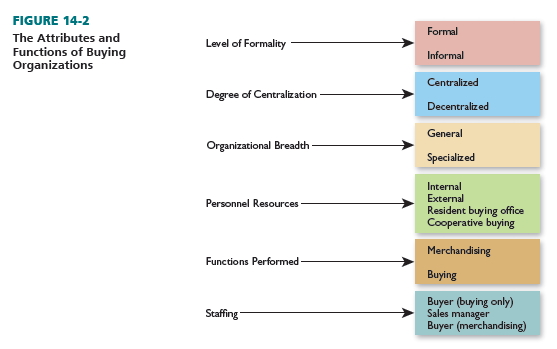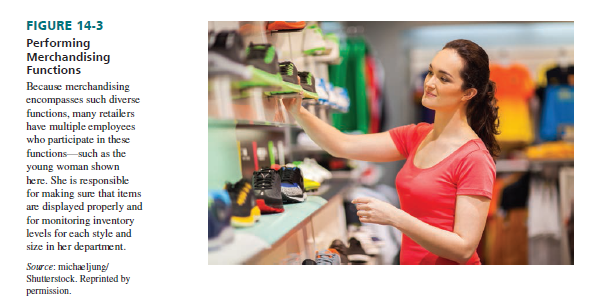A merchandising plan cannot be properly devised unless the buying organization and its processes are well defined: Who is responsible for decisions? What are their tasks? Do they have sufficient authority? How does merchandising fit with overall operations? Figure 14-2 highlights the range of organizational attributes from which to choose.
1. Level of Formality
With a formal buying organization, merchandising (buying) is a distinct retail task and requires the setup of a separate department. The functions involved in acquiring merchandise and making it available for sale are under the control of this department. A formal organization is most often used by larger firms and involves distinct personnel. In an informal buying organization, merchandising (buying) is not a distinct task. The same personnel handle both merchandising (buying) and other retail tasks; responsibility and authority are not always clear-cut. Informal organizations generally occur in smaller retailers.
Advantages of a formal organization are clarity of responsibilities and use of full-time, specialized merchandisers. The disadvantage is the cost of a separate department. Advantages of an informal format are low costs and flexibility. Disadvantages are less-defined responsibilities and less emphasis on merchandise planning. Both structures exist in great numbers. It is not critical for a firm to use a formal department, but it is crucial that it recognizes the role of merchandising (buying) and ensures that responsibility, activities, and operational relationships are defined and enacted.
2. Degree of Centralization
Chain retailers must choose whether to have a centralized buying organization or a decentralized one. In a centralized buying organization, all purchase decisions emanate from one office. A chain may have eight stores, with merchandise decisions made at the headquarters store. In a
decentralized buying organization, purchase decisions are made locally or regionally. A 40-store chain may let each outlet select its own merchandise or divide branches into geographic territories (such as four branches per region) with regional decisions made by the headquarters store in each territory.
Advantages of centralized buying are the integration of effort, strict controls, consistent image, proximity to top management, staff support, and volume discounts. Possible disadvantages are the inflexibility, time delays, poor morale at local stores, and excessive uniformity. Decentralized buying has these advantages: adaptability to local conditions, quick order processing, and improved morale because of branch autonomy. Potential disadvantages are disjointed planning, an inconsistent image, limited controls, little staff support, and a loss of volume discounts.

Many chains combine the formats by deploying a centralized buying organization while also giving store managers some input. Inditex, the Madrid-based global parent company of retail chains such as Zara, Pull & Bear, Massimo Dutti, Bershka, Stradivarius, Oysho, Zara Home, and Uterque, has more than 7,000 stores in 88 countries and online stores in 29 countries. It uses centralized design, buying, and logistics centers for each concept while maintaining flexibility in adapting production to local market demand and customer preferences through 11 clusters that control the supply chain throughout the various stages of design, manufacture, and retailing.8
3. Organizational Breadth
In a general buying organization, one or several people buy all the merchandise for the firm. The owner of a small hardware store, however, will likely buy the merchandise for his or her store. With a specialized organization, each buyer is responsible for a product category. For example, a department store usually has separate buyers for girls’, juniors’, and women’s clothes.
A general approach is better if a retailer is small or there are few products involved. A specialized approach is better if a retailer is large or carries many products. By specializing, there is greater expertise and responsibility is well defined; however, costs are higher and extra personnel are required.
4. Personnel Resources
A retailer can choose an inside or outside buying organization. An inside buying organization is staffed by a retailer’s personnel, and merchandise decisions are made by permanent employees. See Figure 14-3. With an outside buying organization, a firm or personnel external to the retailer are hired, usually on a fee basis. Most retailers use either an inside or an outside organization; some employ a combination.

An inside buying organization is most often used by large retailers and very small retailers. Large retailers do this to have greater control over merchandising decisions and to be more distinctive. They have the financial clout to employ their own specialists. At very small retailers, the owner or manager does all merchandising functions to save money and keep close to the market.
Ross Stores (www.rossstores.com), the off-price apparel chain that operates Ross Stores (1,210 stores in 33 states) and dd’s Discounts (152 stores in 15 states), is an example of a retailer with an inside buying organization. The majority of merchandise in these stores are acquired through opportunistic purchases created by manufacturer overruns and canceled orders during season (“closeouts”) and at the end of a season (“packaways”). Ross operates buying offices in two strategic locations, New York City and Los Angeles, the largest U.S. apparel markets. Its buyers are in the market daily, sourcing opportunities, negotiating purchases with vendors and manufacturers, and strengthening vendor relationships —a critical ingredient in the success of its off-price buying strategies. Ross has separate buying organizations for Ross Stores and dd’s Discounts that employ 700 merchants, merchandise managers, buyers, and assistant buyers across both organizations, with an average of about 8 years of experience at other department stores or off-price retailers.9
An outside organization is most frequently used by small or medium-sized retailers or those far from supply sources. It is more efficient for these retailers to hire outside buyers than to use company personnel. An outside organization has purchase volume clout in dealing with suppliers, usually services noncompeting retailers, offers research, and may sponsor private brands. Outside buying organizations may be paid by retailers that subscribe to their services or by vendors that give commissions. An individual retailer may set up its own internal organization if it feels its outside group is dealing with direct competitors or the firm finds it can buy items more efficiently on its own.
The Doneger Group (www.doneger.com), founded in 1946, is one of the leading outside buying firms, with hundreds of retailer clients. Through its Price Point Buying (PPB) division, Donegar identifies opportunistic buys and facilitates business relationships between its retail clients and vendors in the competitive, fast-changing, value-driven retail industry. It is the industry’s leading source of global trend intelligence, creative design services, focused and seasonal merchandising direction, expert analysis of the retail business, trend forecasting, and comprehensive market information.10
A resident buying office, which can be an inside or outside organization, is used when a retailer wants to keep in close touch with key market trends and cannot do so through only the headquarters buying staff. Such offices are situated in vital merchandise centers and provide data and contacts. Worldwide, several specialized firms operate resident buying offices. For instance, the VIB Group, based in Milan, Italy, has a major resident buying office for international retailers. The VIB Fashion Consulting Buying office acts as a local representative of international clients providing a broad range of services, including market analysis, product portfolio reviews, assisting client company buying staff in making the right decisions in tune with local market preferences and intricacies, and developing relationships with vendors. VIB also acts in fulfilling supply requirements of clients in terms of price and contract negotiations, export documentation, compliance with import countries’ legislation, and buying merchandise on their behalf.11 Besides the large players, there are many smaller outside resident buying offices that assist retailers.
Today, independent retailers and small chains are involved with cooperative buying to a greater degree than before to compete with large chains. In cooperative buying, a group of retailers gets together to make quantity purchases from suppliers and obtain volume discounts. It is most popular among consumer electronics, food, hardware, and drugstore retailers. One such entity is BrandSource, which represents 4,500 member stores that together account for $14 billion in annual purchases.12 In addition to major appliances, BrandSource-affiliated retailers sell consumer electronics, bedding, home furnishings, and floor coverings. The cooperative also plans and implements promotional programs, as well as wholesale and retail financing, for its members.
As another cooperative buying illustration, the Federation of Pharmacy Networks (FPN) comprises 22 member-buying groups across the United States. It represents more than 15,000 independent drugstore owners. Other consumer electronics buying groups (in the field of electronics) include Mega Group USA, Nationwide Marketing Group, and NATM Buying Corporation.
5. Functions Performed
At this juncture, the responsibilities and functions of merchandise and in-store personnel are assigned. With a “merchandising” view, merchandise personnel oversee all buying and selling functions, including assortments, advertising, pricing, point-of-sale displays, employee utilization, and personal selling approaches. With a “buying” view, merchandise personnel oversee the buying of products, advertising, and pricing, whereas in-store personnel oversee assortments, displays, employee utilization, and sales presentations. The functions undertaken must reflect the retailer’s level of formality, the degree of centralization, and personnel resources.
6. Staffing
The last organizational decision involves staffing. What positions must be filled and with what qualifications? Firms with a merchandising viewpoint are most concerned with hiring good buyers. Firms with a buying perspective are concerned about hiring sales managers, as well. Many large firms hire college graduates, train them, and promote them to buyers and sales managers.
A buyer is responsible for selecting the merchandise to be carried by a retailer and setting a strategy to market that merchandise. He or she devises and controls sales and profit projections for a product category (generally for all stores in a chain); plans proper merchandise assortments, styling, sizes, and quantities; negotiates with and evaluates vendors; and often oversees in-store displays. He or she must be attuned to the marketplace and travel to the marketplace when needed, be able to bargain with suppliers, and be capable of preparing detailed plans. A sales manager typically supervises the on-floor selling and operational activities for a specific retail department. He or she must be a good organizer, administrator, and motivator. A merchandising buyer must possess attributes of each. Most retailers believe the critical qualification for good merchandisers is an ability to relate to customers and methodically anticipate future needs. In addition, to some extent, buyers are involved with many of the remaining tasks described in this and the next chapter.
Macy’s, Inc., which operates the Macy’s and Bloomingdale’s department store chains, has career tracks that recognize the value of both merchandising and in-store personnel. Figure 14-4 shows two distinct career tracks.
Source: Barry Berman, Joel R Evans, Patrali Chatterjee (2017), Retail Management: A Strategic Approach, Pearson; 13th edition.

Very nice post. I just stumbled upon your weblog and wanted to say that I’ve truly enjoyed browsing your blog posts. In any case I’ll be subscribing to your rss feed and I hope you write again very soon!
Thank you for writing this post. I like the subject too.
I have to thank you for this article
Thanks for writing this article